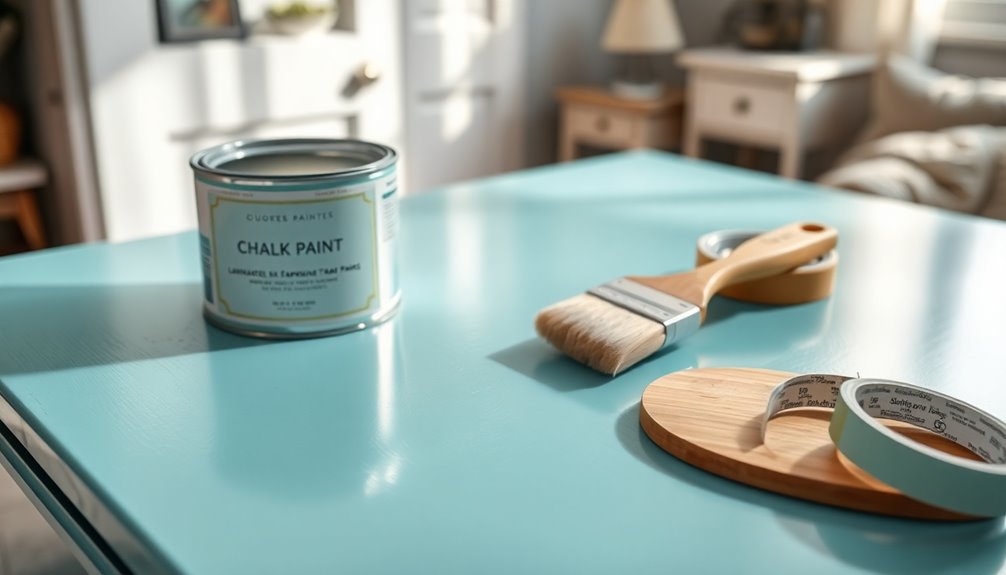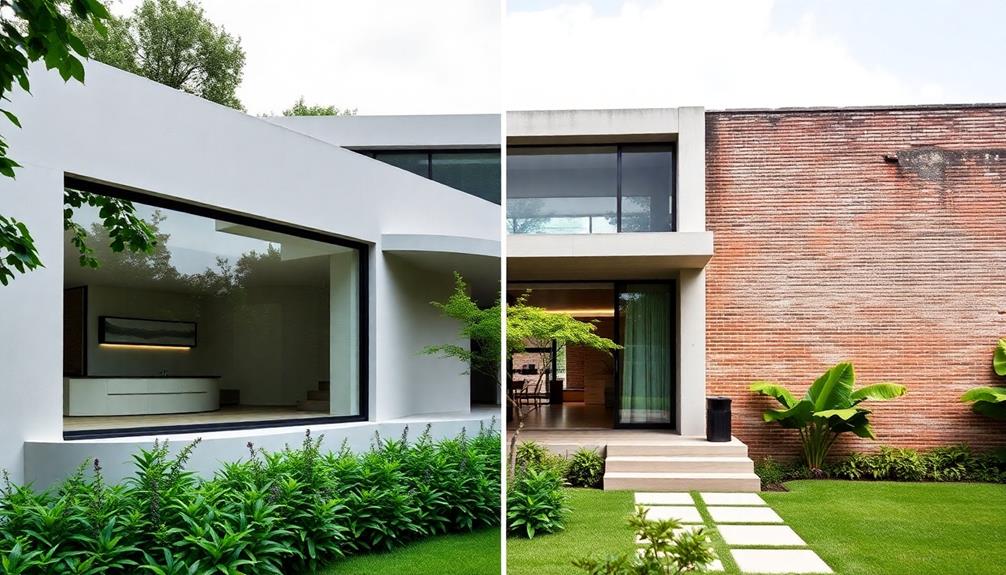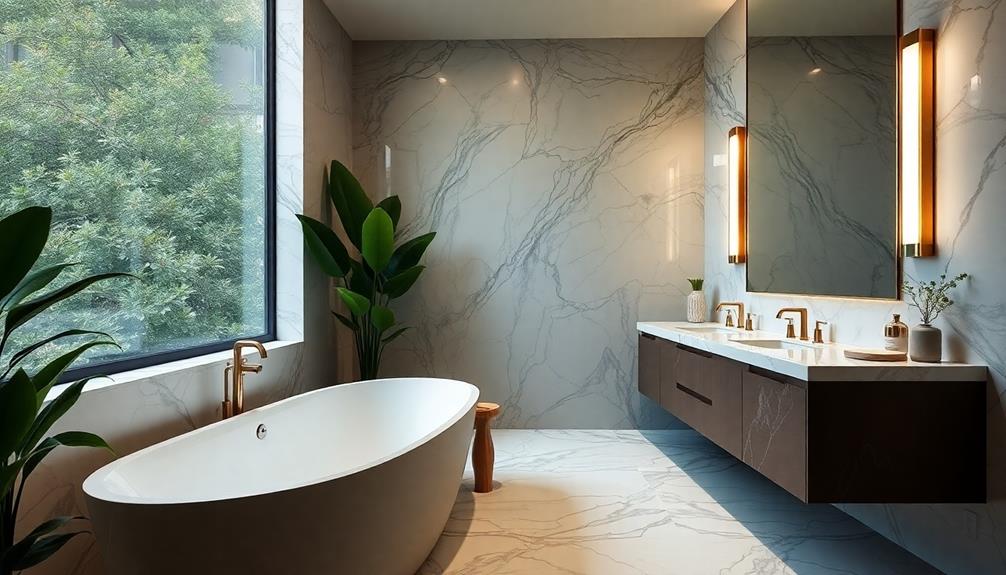You can easily paint laminate furniture without sanding by first cleaning the surface with a degreaser like Krud Kutter. Next, use a suitable primer—oil-based or shellac-based—for better adhesion. Apply two thin coats of primer, letting it dry overnight. Choose a durable, water-based latex paint for the top layer and work in sections with foam rollers to avoid drips. Finish with a protective topcoat like Minwax Polycrylic for extra durability. Make sure to work in a well-ventilated area for safety. If you want more tips on achieving the best results, there’s plenty more to explore! After applying the protective topcoat, allow the furniture to cure for at least 24 hours before using it to ensure the best finish. If you’re looking for guidance on specific techniques or common pitfalls, resources are available that explain how to paint glossy furniture effectively and achieve a professional appearance. Remember, patience is key in this process to avoid any mistakes and enjoy a beautifully refreshed piece!
Key Takeaways
- Clean the laminate surface thoroughly using a degreaser and TSP to remove dirt and grease for better paint adhesion.
- Use Krud Kutter Gloss-Off to dull the shine on the laminate, enhancing primer and paint bonding.
- Apply at least two thin coats of a suitable primer, like oil-based or chalk paint, to prepare the surface for painting.
- Choose durable, water-based latex or acrylic paint for a smooth finish and excellent adhesion on the primed surface.
- Finish with a protective topcoat, such as Minwax Polycrylic, to guard against wear and extend the life of your painted furniture.
Preparing the Surface
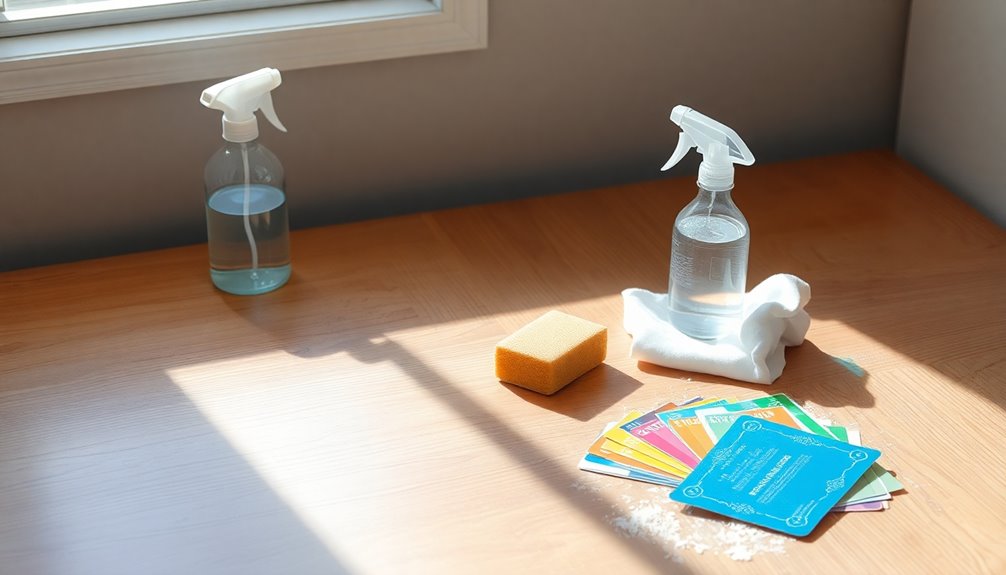
Before you dive into painting your laminate furniture, it's crucial to prepare the surface properly. Start by cleaning the surface with a mild cleaner or sugar soap to remove any grease or residue. Scrub it down with a degreaser like Krud Kutter, then thoroughly wipe it with TSP (trisodium phosphate) to ensure it's free from dirt and grime. Don't forget to use a tack cloth to remove any cleaning residue.
Next, you'll need to reduce the shine and gloss of the laminate. Apply a product like Krud Kutter Gloss-Off, let it dry, and wipe off any excess. This step is vital for promoting better paint adhesion. If you prefer, you can use liquid sandpaper as an alternative to traditional sanding.
Lightly scuff the surface with a medium-grit sanding sponge or sandpaper (120-150 grit). This creates a rough texture for the paint to grip onto. Be gentle—there's no need for heavy force or an electric sander. Finally, vacuum or wipe off any dust from scuffing, ensuring the surface is completely dry and clean before you start painting. Remember that using a shellac-based primer is essential for achieving a durable finish when working with laminate furniture.
Choosing a Suitable Primer
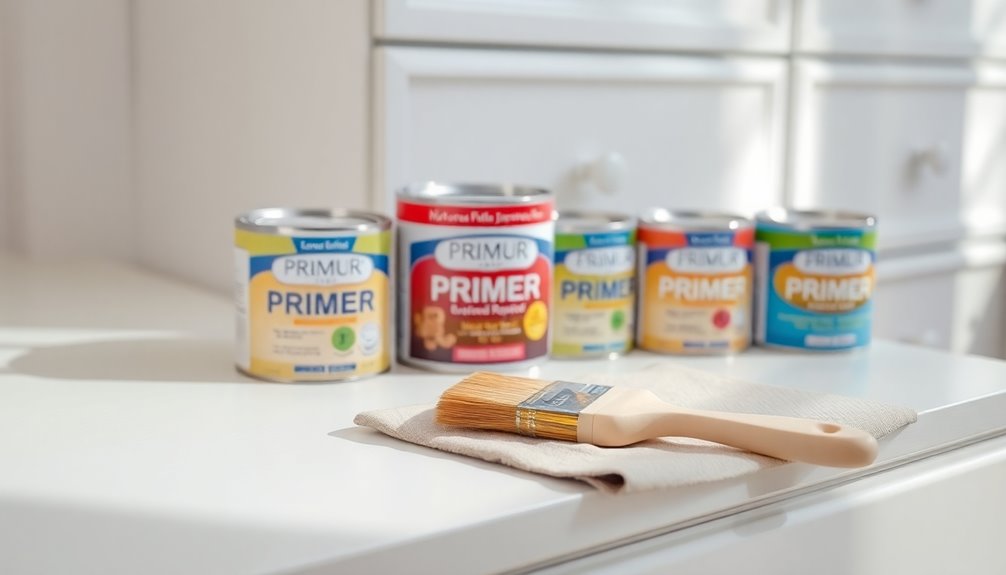
Choosing the right primer is essential for achieving a lasting finish on laminate furniture. You have several excellent options to consider based on your needs. Oil-based primers, like Kilz Original Primer, are a top choice for ensuring strong paint adhesion. They bond well to slick surfaces without requiring any sanding, but be sure to work in a well-ventilated area due to their strong fumes.
Another option is a shellac-based primer, such as BIN, which provides great adhesion and effectively blocks stains. While it's not needed for laminate, it's a solid choice if you're concerned about discoloration. Just remember to clean your brushes with denatured alcohol or ammonia afterward.
If you're looking for a more cost-effective approach, consider using chalk paint as a primer. Mixing latex primer with Plaster of Paris gives you a gritty surface that helps subsequent layers adhere without sanding.
Lastly, Isl-x Stix Primer is a durable alternative that bonds well to laminate and other materials, offering excellent scratch resistance. Whichever primer you choose, make sure it suits your project's requirements for the best results. Additionally, using a high-quality primer can significantly enhance the durability and finish of your painted laminate furniture.
Applying Primer Evenly
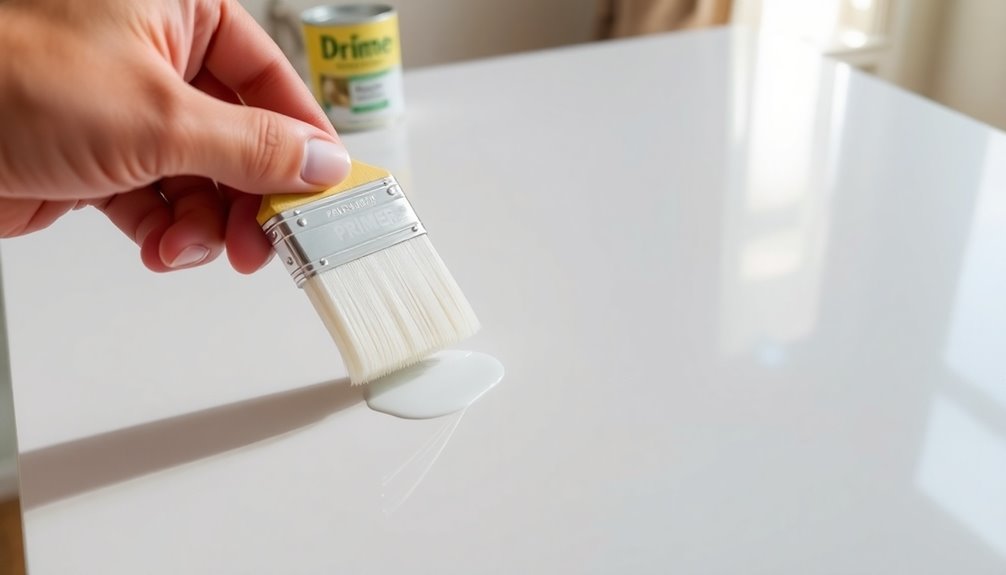
Once you've selected the right primer, applying it evenly is key to achieving a smooth finish on your laminate furniture. Start by thoroughly cleaning the surface to remove dirt and grime. Use a degreaser to eliminate any glossy finish and ensure the surface is free of dust. Don't forget to remove any hardware that might complicate your painting process.
For application, consider using a smooth roller for large areas and a foam roller to minimize splattering. If you're dealing with detailed sections, a high-quality synthetic brush works best. Make sure to mix the primer well, shaking the spray can thoroughly if that's your choice.
Apply at least two thin coats of primer, allowing each one to dry completely overnight for optimal adhesion. Applying multiple thin coats is essential to prevent drips and ensure even coverage. Work in sections to maintain even coverage and avoid drips. Use a paint tray for better control, and always apply with a light touch to prevent pooling. After the first coat, check for missed areas to ensure your base is as flawless as possible. Finally, let the primer set for a full 24 hours before moving on to the next step.
Selecting the Right Paint
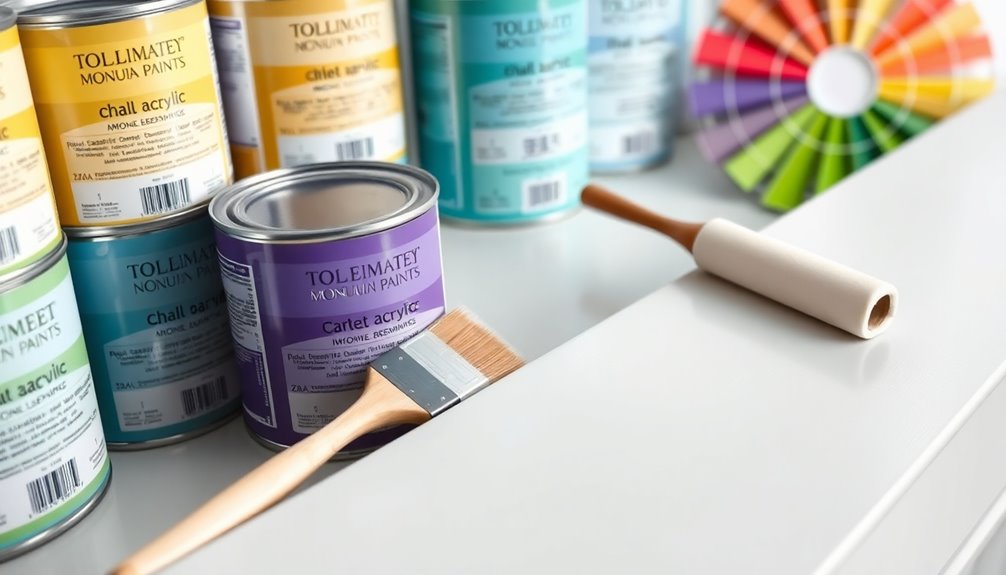
Selecting the right paint for your laminate furniture is crucial for achieving a durable and attractive finish. Start by choosing a topcoat that works well with your primer. Durable, water-based latex paint is a solid option, ensuring a smooth and lasting result. You might also consider acrylic-based paint, which provides good adhesion and durability. For an even tougher finish, waterborne alkyd enamel paint is another excellent choice. Additionally, using energy-efficient technology can help reduce the environmental impact of your painting project.
If you prefer a simpler approach, look into chalk paint. It can serve as both a primer and a topcoat, removing the need for additional products. Rust-Oleum Chalked is a popular brand that adheres well to laminate and offers a beautiful ultra-matte finish. Mixing latex primer with chalk paint ingredients can further enhance adhesion. Choosing the right primer is essential as it significantly impacts the paint's overall adhesion and longevity on laminate surfaces.
Painting Techniques and Tips
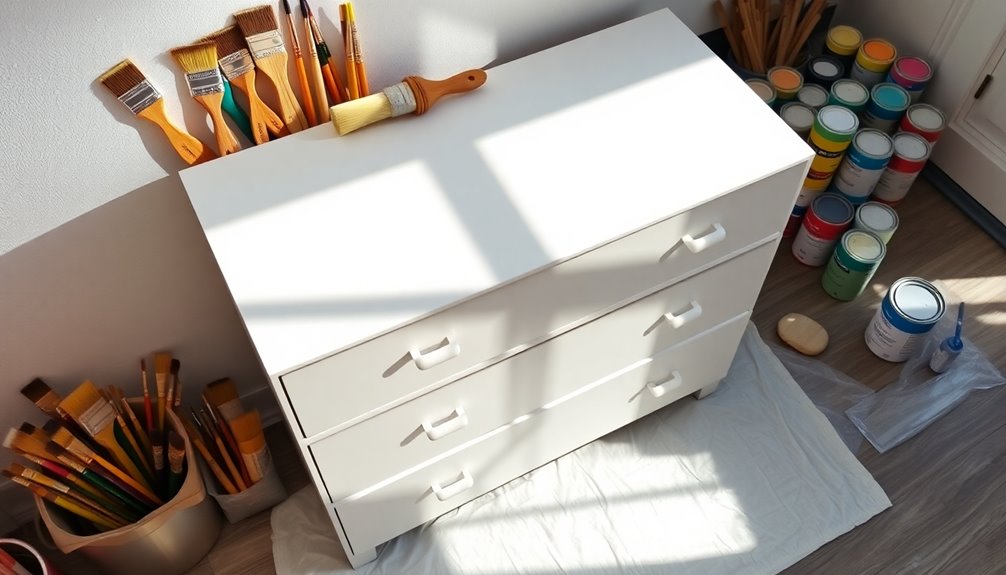
To achieve a professional-looking finish on your laminate furniture, mastering essential painting techniques is key. Start by thoroughly cleaning the surface with a wet rag or mild cleaner to remove any dirt and debris. If your furniture has been in storage or on display, use sugar soap to tackle grease and residue. Don't forget to remove any hardware that might complicate your painting process.
Next, consider using liquid sandpaper, like Klean Strip Liquid Sandpaper, to prepare the surface without traditional sanding. Follow the manufacturer's instructions for application, as this method creates a suitable surface for paint adhesion. Keep in mind that laminate furniture often requires special primers for optimal results.
Once prepped, apply a high-quality bonding primer designed for laminate. Use a synthetic bristle brush or foam roller for a smooth, even coat, and make sure the primer dries completely before moving on to paint.
When painting, apply latex paint in thin, even coats, allowing each coat to dry fully before adding another—waiting a day between coats yields the best results. Finish with a durable topcoat like Minwax Polycrylic to seal the paint and prevent peeling. Regular maintenance will help extend the life of your new finish.
Special Considerations for Laminate
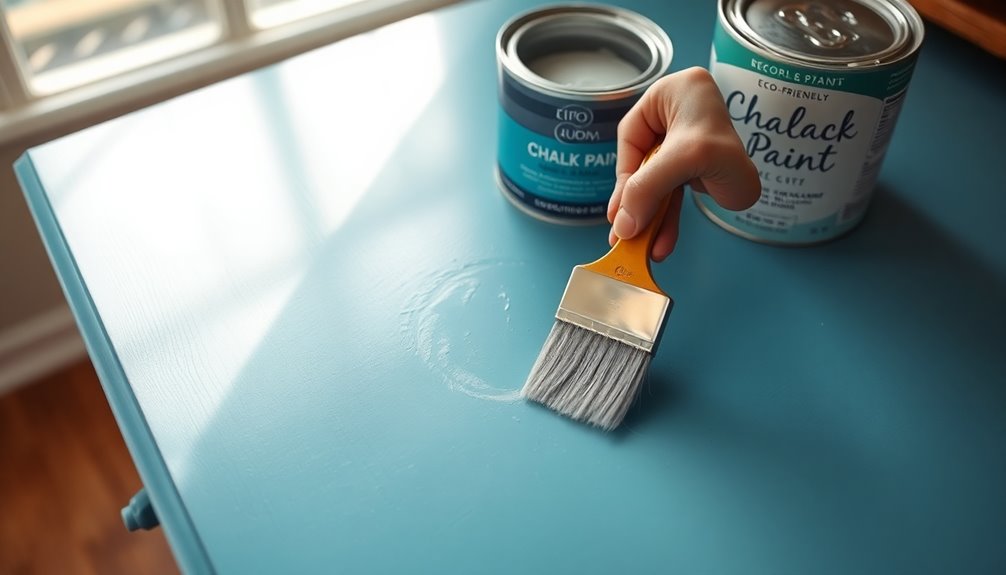
When working with laminate furniture, it's crucial to understand its unique properties to ensure a successful paint job. Start by using a shellac-based primer, as it's essential for proper adhesion to laminate surfaces. This primer dries quickly and effectively seals any stains or knots you may encounter. While you can achieve good results without sanding, lightly scuffing the surface with medium-grit sandpaper is recommended to enhance adhesion. Just be careful not to over-sand, as this could damage the laminate. Additionally, laminate's durability against scratches makes it an ideal choice for high-traffic areas, ensuring your painted furniture remains looking fresh longer.
After scuffing, make sure to clean the surface thoroughly to remove any dust or debris. For cleaning, a TSP substitute with scouring pads works well. When choosing paint, water-based options are easier to manage, but oil-based primers can improve adhesion. Chalk paint is an exception, allowing you to skip priming altogether. Keep an eye on humidity levels while painting, as lower humidity encourages better adhesion. Lastly, always ensure you're working in a well-ventilated space, especially if using oil-based products. These considerations will set you up for a successful and long-lasting finish on your laminate furniture.
Topcoat Options for Durability
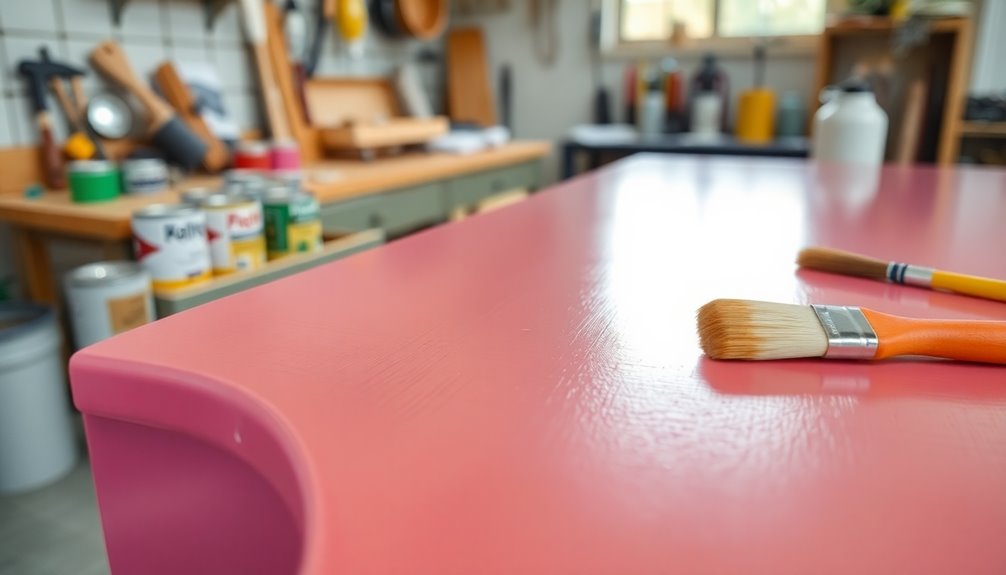
A durable topcoat is essential for protecting your newly painted laminate furniture and ensuring it withstands daily wear and tear. Two excellent options for topcoats are polyurethane and water-based finishes. Polyurethane provides a scrubbable surface that resists fingerprints and smudges. When applying, use a high-quality paint brush or sprayer to achieve an even finish, and make sure to stir the product thoroughly before use. Remember to apply thin layers to minimize bubbles and allow each layer to dry completely. Proper preparation is crucial for achieving the best results with your topcoat. Additionally, selecting a topcoat with energy-efficient options can help in reducing your overall product usage.
Water-based topcoats are particularly recommended for high-traffic areas like kitchens and bathrooms. They're more durable than wax and won't melt in the sun. Products like Minwax Polycrylic offer a clear finish that serves as a protective barrier, while General Finishes High-Performance Topcoat gives extra durability.
Regardless of the option you choose, always ensure good ventilation during application. Prioritize cleaning the laminate surface before topcoating to remove any dust. With proper application and care, your laminate furniture will remain beautiful and resilient for years to come.
Essential Tools and Materials
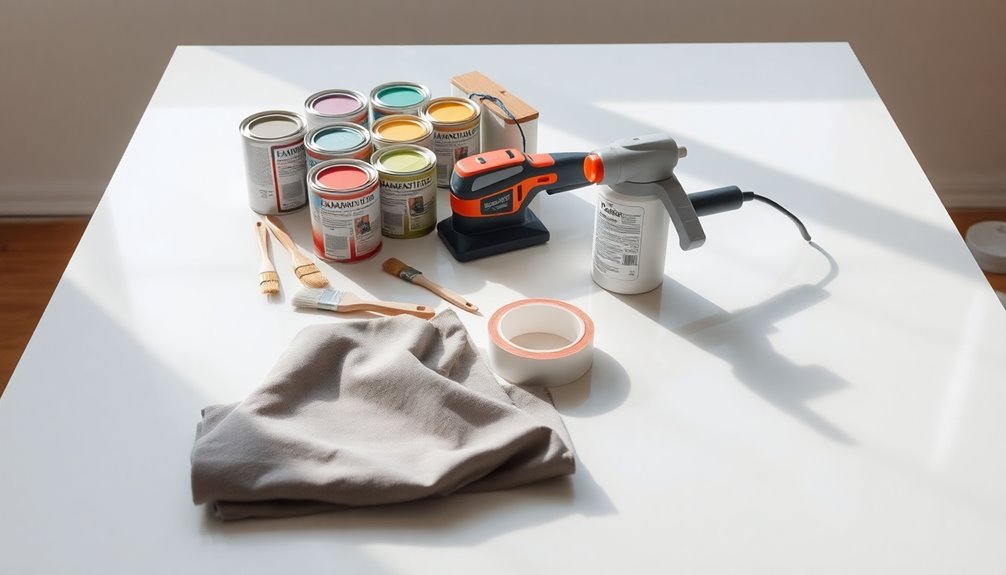
Before diving into painting your laminate furniture, gathering the right tools and materials is crucial for a successful project. Start with primers that adhere well to laminate surfaces. Zinsser BIN Shellac-Based Primer and Kilz Original Primer are excellent choices. If you prefer a chalk paint primer, consider one made from latex primer and Plaster of Paris. Additionally, using a specific primer is essential for ensuring the paint adheres properly to the laminate.
Next, you'll need the right painting tools. A small foam roller and a high-density 4″ foam roller work well for even application. Don't forget disposable foam brushes and a 1.5″ angled brush for corners and edges. A high-quality paintbrush or fine finish roller can enhance the final look.
Prepare your surfaces by cleaning them thoroughly. Use a cleaner like TSP for dirt and a degreaser or microfiber cloth for grime. Have tack cloths or lint-free rags handy for wiping down surfaces, and protect your area with drop cloths or old sheets.
Additional essentials include a respirator mask for safety, and optional tools like a Wagner Flexio 3000 Sprayer for a professional finish. Lastly, don't forget hardware removal tools, like a screwdriver, to make your work easier.
Safety Precautions While Painting
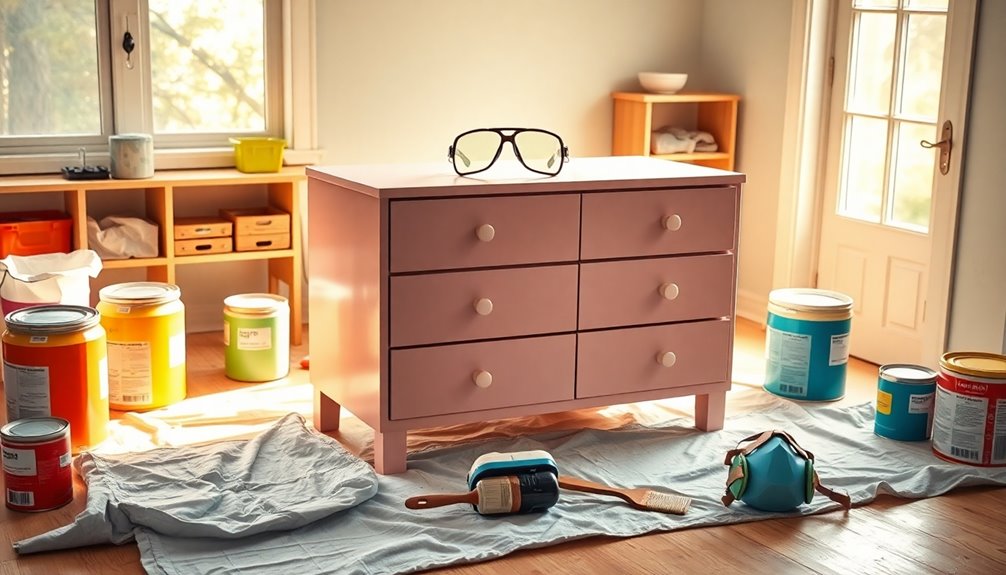
How can you ensure a safe painting experience? Start by painting in a well-ventilated area to avoid inhaling harmful fumes. Choose paints with low VOCs to improve air quality. Always wear gloves and safety glasses to protect your skin and eyes from splashes during the application process. When applying paint, use thin, even coats to minimize drips and ensure a smooth finish. Additionally, remember that painting laminate furniture is a viable option that avoids the challenges of removing laminate.
Next, take care of your work area. Cover it with a tarp or drop cloth to catch any spills. Remove flammable materials from the vicinity, and keep the area clutter-free to prevent accidents. Make sure the lighting is adequate, so you can see what you're doing clearly. It's also crucial to keep children and pets away from your painting space to avoid any mishaps.
Finally, be cautious of hot surfaces and open flames while painting. Store your materials safely, and always follow the instructions on your paint for the best results. By following these safety precautions, you can enjoy a successful painting project while minimizing risks.
Curing and Finishing Touches
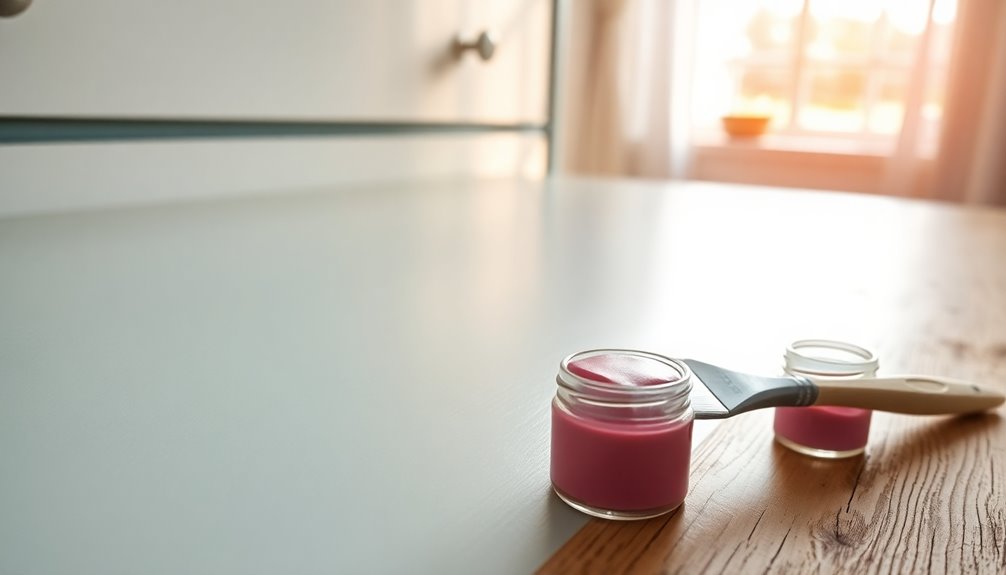
Curing and finishing touches are essential steps in transforming your painted laminate furniture into a durable and attractive piece. Start by allowing the paint to dry completely, usually around 24 hours, but ensure it cures for days to months before heavy use. Low humidity will help speed up this process, while high humidity can delay it. During curing, avoid placing hot or sharp items directly on the surface and clean up spills immediately to protect the paint. Additionally, proper prep work is crucial to ensure that the paint adheres as effectively as possible during this process.
Next, apply a durable topcoat like Minwax Polycrylic Protective Finish to seal the paint and prevent peeling. Follow the manufacturer's instructions for application and drying times. Once the topcoat is fully dry, you can enhance your furniture with finishing details. Consider lining drawers with peel-and-stick wallpaper, painting hardware, or using spray paint for small details. Remember to clean and restore any original hardware before reattaching it.
Finally, ensure all finishing touches are completely dry and cured before using the furniture. Regular maintenance is crucial, so wipe up spills promptly, avoid extreme temperatures, and inspect for any signs of wear to ensure your revitalized piece lasts for years to come.
Frequently Asked Questions
Can I Skip Primer When Painting Laminate Furniture?
You might be tempted to skip primer when painting laminate furniture, but it's not a great idea. Without primer, paint often beads up or peels off, leaving you with a messy finish. If you want good adhesion and durability, using a primer is essential. However, chalk paint can act as both a primer and paint, allowing you to bypass traditional primers while still achieving decent results. Always clean the surface first for the best outcome!
How Long Does the Entire Process Take?
The entire process of painting furniture can take several days to a week. You'll spend a few hours on preparation, including cleaning and priming. Once you start painting, allow time for multiple coats, which could take another day. After that, applying a topcoat will take a few more hours. Finally, wait several days for everything to cure properly before using the furniture. Patience is key for a beautiful finish!
What Should I Do if Paint Peels Off?
If paint peels off, first assess the damage to see if you need a complete repaint or just touch-ups. Clean the area with an all-purpose cleaner and let it dry. Use a scraper to remove the peeling paint, then dull the glossy finish with medium grit sandpaper. Reapply primer and paint, ensuring each layer dries completely. To prevent future peeling, focus on thorough surface preparation and use high-quality products.
Can I Use Spray Paint on Laminate Furniture?
Yes, you can use spray paint on laminate furniture, but it's essential to pair it with the right primer for best results. Choose an oil-based primer to ensure good adhesion, and make sure to apply it evenly. Once the primer dries, spray paint your furniture in well-ventilated areas. Follow the manufacturer's instructions and consider multiple coats for complete coverage. With the right preparation, you'll achieve a smooth, attractive finish.
Is It Safe to Paint Indoors Without Ventilation?
No, it isn't safe to paint indoors without ventilation. You risk exposing yourself to harmful VOCs that can cause nausea, headaches, and respiratory issues. Make sure to open windows and use fans to keep the air flowing. If possible, ventilate the area for at least three days after painting to ensure any lingering fumes dissipate. Protect your health by creating a safe environment while you work on your projects.
Conclusion
By following these steps, you can easily transform your laminate furniture without the hassle of sanding. Just remember to prepare the surface, choose the right primer and paint, and apply everything evenly for a smooth finish. Don't skip the topcoat for added durability, and always prioritize safety while you work. With a little patience and creativity, you'll give your furniture a fresh look that lasts. Enjoy your revamped space and the satisfaction of a job well done!
